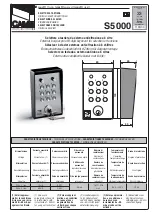
ADVANCED APPLICATIONS
© 1985, 1986, 1987 E-mu Systems, Inc. Page 202
For an example of how to use more than 5 Voices, load the piano disk, pick one of the
Presets, and call up Preset Definition 23 (Edit Voice) to see how the Voices are
assigned.
Hint:
It is good practice to, if possible, sample an additional Voice or Voices an octave
above and/or below the intended sampling range. Then, it will be possible to do octave
layering, bass sounds, and other tricks later on if desired.
Now let’s assign potential Preset numbers, and assume that we will want about 10
Presets per sound.
Electric Piano:
Presets 01 – 09
Trumpet:
Presets 10 - 19
Gong:
Presets 20 - 29
Noise:
Presets 30 - 39
Synth 1:
Presets 40 - 49
Synth 2:
Presets 50 - 59
Synth 3:
Presets 60 - 69
We will make the first Preset of each group as pure and unmodified a sound as possible.
We will then replicate some of the Presets, thereby creating Presets with different Voice
numbers. These can then be modified to produce variations on the first Preset. Note that
if we take five samples per Voice, we will still have 65 Voices left after taking our original
samples -- enough to replicate many five-Voice Presets.
III. Sampling the Voices
Hint:
When sampling synthesized sounds, keep the synth filter wide open and use the
Emulator II filter instead for filter control. Open up the synth’s VCA’s since dynamics can
also be set with the Emulator II.
1. Start sampling by clearing the Bank. Upon clearing the Bank, the Emulator II
creates a Preset for you (P01) and names it NULL PRESET. During sampling, if
you assign Voices to the keyboard as they are being sampled (SAMPLE 2), they
will fill up this Null Preset. If you don’t want to bother with assigning Voices just
yet, you could also just sample Voices, one right after another, into the default
assignment (i.e. lowest two octaves). The newest sample will over-write the
previous sample, but the previous sample will still be stored in memory. After all
the sampling is done, the Voices can then be assigned to a Preset.
Assigning the Voices as you go along saves a step, but sampling Voices in quick
succession often gives a better “rhythm”. For now, we’ll go with the latter method.
2. Activate the sample module. After adjusting the gain, thresholds, and so on,
carefully consider your signal source. Suppose we’re sampling the electric piano
sound, and that this particular synth piano note has a complex percussive attack,
which becomes a sustained tone. A good plan might be to sample the complex
attack, then loop the sample as soon as the sustained tone begins. Looping the
sustained part of the tone shortens the sample, saves memory, and gives infinite
sustain if desired. Dynamics can be adjusted later with the Emulator II’s VCA’s.
Summary of Contents for EII+
Page 11: ...INTRODUCTION 1985 1986 1987 E mu Systems Inc Page 11 INTRODUCTION ...
Page 20: ...INTRODUCTION 1985 1986 1987 E mu Systems Inc Page 20 ...
Page 26: ...THE GUIDED TOURS 1985 1986 1987 E mu Systems Inc Page 26 THE GUIDED TOURS ...
Page 84: ...VOICE DEFINITION MODULE 1985 1986 1987 E mu Systems Inc Page 84 Fig VDEF 8 Fig VDEF 9 ...
Page 118: ...PRESET DEFINITION MODULE 1985 1986 1987 E mu Systems Inc Page 118 ...
Page 168: ...ENTER MODULE 1985 1986 1987 E mu Systems Inc Page 168 ENTER MODULE ...
Page 214: ...SMPTE SUPPLEMENT 1985 1986 1987 E mu Systems Inc Page 214 SMPTE SUPPLEMENT OVERVIEW PROTOCOL ...
















































